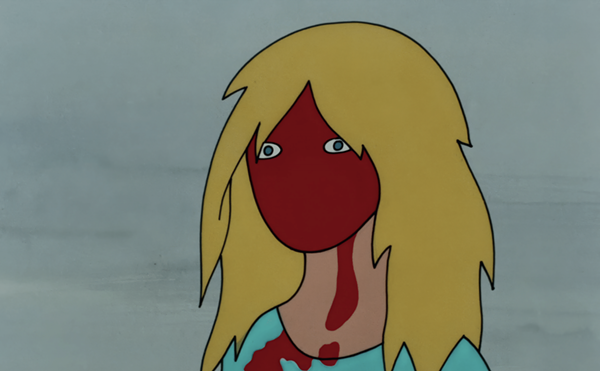The exhibition begins with a wide tabletop full of short human figures based on funerary guardians from China's T'ang Dynasty, even though they've been pulled through Gothic sculptor Nicola Pisano and salted with a bit of German Expressionism. Carved roughly from wood, the figures are then painted with casein in a style that seems to draw from impressionist watercolors. Indeed Chu's nearby watercolor studies, executed with admirable economy and freshness, clearly informed the carved works.
Despite all the references to historical art sources, Chu's work has its own distinct personality. If the ancient guardian figures had a lively dignity, Chu's figures additionally project a humble awkwardness -- some strutting and scowling, others wearing quiet faces belied by a profusion of color -- suggesting a deeply poetic soul. A few of them ride fat bronze horses, their bodies strong, their gazes fixed somewhere in the distance.
Deprived of their funerary function, Chu's figures engage in another kind of drama, one unrelated to the voyage into the afterlife. They don't suggest any one particular narrative (which could be construed as cheesy), but instead embody varying states of dignity and emotion. This characteristic places them in a Western context of expression for its own sake.
The dichotomy between the Asian and European worlds appears to have taxed the curator's catalogue essay more than the artist. The main room of the exhibition features Chu's series of life-size marionettes that she says freed her to "make figurative sculpture without working within the classical European tradition." This is somewhat confusing when her other works openly reference European sarcophagi lids and armor without concern. As an aside, this ambiguity exemplifies the only substantial problem with the museum's presentation: Curator-director Bonnie Clearwater has difficulty pinning this particular butterfly of an artist -- which is, perhaps, as it should be. An artist's production ought to provide enough nuance and complexity so as to resist neat written explanation. The catalogue also contains unacceptable rhetorical overstatement. One passage likens Chu's work to minimalist sculpture in a strained and unconvincing manner. Both catalogue and wall text labor the funerary figures' resemblance to ceramics and state, "This illusionism is crucial to the experience of the work as it challenges the viewer's perception and stimulates a suspension of disbelief." The similarity, though, falls far short of illusionism. In fact my museum-going companion was prompted to say, "You mean, like, 'I can't believe it's not butter?'"
In fairness, Clearwater's text sometimes saves the day. One sculpture appears to be a pure abstraction, and a handsome one at that. A rugged yellow cone juts from the floor, point down, with another gray form appended to it at the top -- some kind of bent protrusion. Alas, the label explains that the viewer is looking at a piece called Two Legs, representing the adjacent lower limbs of an armored, mounted knight and his horse. Thereafter Two Legs flips tantalizingly between abstraction and representation, playing with perception like an optical illusion.
Clearwater's text also clarifies two other works in the museum's pavilion, specifically the artist's intention for the space between their distant parts to function like the space in her watercolors. This intriguing idea works well in one, Guardian and House. This piece depicts a stumpy bronze figure with a surface like barnacles and an upraised fist, hanging from the ceiling above a building rendered in the style of Chinese funerary architectural models, but made of orange urethane. The proportions of the two forms echo one another, and the space between them conveys a comical yet spiritual narrative of otherworldly protection. However, a similar piece consisting of a tall ceramic court figure and a little bronze house doesn't coalesce; its parts are too disparate and misplaced.
Back to those marionettes. They are the stars of this show, dominating the main space at MoCA with their sizable physical and psychological presence. Chu created them using a wide range of materials: wood, ceramic, cloth, and more around wire armatures. Long strands of rope suspend the heads and hands; many of them could be made to work, given a team of strong puppeteers at a high elevation. In perhaps the most elegant, Charming Girl, a cloaked woman with a wooden head and hands, wearing a velvet blue and brown robe, kneels before a standing boy, somewhat smaller than she, to whom she's tethered by a wire held in one hand. She closes her eyes, reveling in the royal power she wields over him, while he gestures with an open palm that she fails to see. It's hard to miss Bestial, a demon figure with a frightening countenance, bear paws, and a pear-shaped body, dressed in a patchwork of cloth stretched over a wire armature, rising five feet high while seated on its bulbous rear end.
Chu has also produced marionette landscapes, a poetic, counterintuitive act that either references or recalls the same spirit as Zen master Dogen's Mountains and Rivers Sutra: "The blue mountains are constantly walking.... The walk of the mountains is like that of men; so we must not doubt that the mountains walk simply because they may not appear to stride like humans." To the gods, worldly landscapes must appear mobile, and Chu interprets them with cloth skins, gesturally but beautifully embroidered with a patchwork of colors.
The exhibition amply displays Chu's watercolor studies, some of which she has built up to an opaque skin, others simply executed with a charming flair that reflects the best watercolor traditions of both the Eastern and Western worlds. This dual-worldly existence that seems to transcend time animates her work with a courageous energy that combines artistic polymath with an array of technical talents. It is that energy which makes the Anne Chu exhibit a tour de force.












